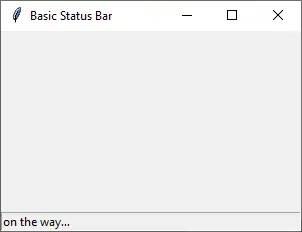Tkinter 教程 - 状态栏
Jinku Hu
2024年2月15日

状态栏通常是 GUI 底部的窄条,用于指示一些额外的信息,例如文件的字数统计或可能为用户界面增加额外价值的任何内容。
Tkinter 没有专用的状态栏控件,但可以使用具有合理配置的标签控件作为 GUI 中的状态栏。
Tkinter 状态栏
import tkinter as tk
app = tk.Tk()
app.geometry("300x200")
app.title("Basic Status Bar")
statusbar = tk.Label(app, text="on the way…", bd=1, relief=tk.SUNKEN, anchor=tk.W)
statusbar.pack(side=tk.BOTTOM, fill=tk.X)
app.mainloop()

statusbar = tk.Label(app, text="on the way…", bd=1, relief=tk.SUNKEN, anchor=tk.W)
bd 设置边框的大小,relief 设定标签的显示方式。我们希望标签看起来有些凹陷,这样状态栏看起来就像是窗口的一部分。
anchor 设置标签内文本的对齐方式。W 意思是 West 或左对齐。
statusbar.pack(side=tk.BOTTOM, fill=tk.X)
此状态栏位于 GUI 的底部,如果我们调整窗口大小,它将始终覆盖窗口的整个宽度。
作者: Jinku Hu
Founder of DelftStack.com. Jinku has worked in the robotics and automotive industries for over 8 years. He sharpened his coding skills when he needed to do the automatic testing, data collection from remote servers and report creation from the endurance test. He is from an electrical/electronics engineering background but has expanded his interest to embedded electronics, embedded programming and front-/back-end programming.
LinkedIn